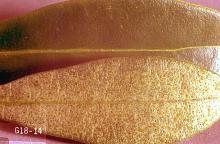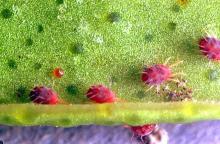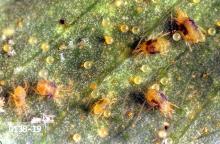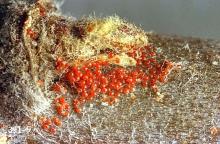Brown mite (Bryobia rubrioculus)
European red mite (Panonychus ulmi)
McDaniel mite (Tetranychus mcdanieli)
Twospotted spider mite (Tetranychus urticae)
Yellow spider mite (Eotetranychus carpini borealis)
For mite identification, see:
Field Characteristics of Fruit-Tree-Attacking Spider Mites in the Pacific Northwest
Pest description and crop damage All adult mites are small, usually only about 0.02 inch in length and have eight legs. The various pear-infesting species vary in appearance as follows:
Brown mite: The adult female is a dull reddish brown with dark orange markings, and somewhat flattened. The front legs are very long, over twice the length of the other legs, and extend forward from the body.
European red mite: Adults are globular and reddish with white spines. Immatures are similar in appearance, only smaller. Eggs are red, globular and have a stripe.
Twospotted and McDaniel mite: Adults are yellowish-brown, about 0.02 inch in length. Twospotted mites have two dark spots on the body, while McDaniel mites have four. Immatures are similar in appearance, only smaller. Eggs are round and translucent to opaque.
Yellow spider mite: Adult females are pale yellow to white with two or three dark, rectangular markings on each side of the abdomen. Immatures are similar in appearance to the twospotted spider mite, but have more of a yellowish color. Eggs are clear and spherical.
Spider mites damage leaves by puncturing cells and sucking out the contents resulting in foliar injury, varying from leaf yellowing and stippling to bronzing and blackening. High populations of spider mites can cause significant defoliation.
Biology and life history Twospotted, McDaniel and yellow spider mites overwinter as fertilized females under bark or in soil debris. European red mite and brown mites overwinter as eggs in crevices of twig bark and young limbs. They move to young foliage when buds break in spring and produce many generations from spring to autumn. Females can lay up to 10 eggs per day and more than 200 during their lifetime. Egg-to-adult development can occur in seven to ten days during summer. They thrive under hot, dry conditions. Large colonies of mites produce webbing. Dispersal occurs mainly through wind transport via ballooning on their webbing.
Pest monitoring Economic damage can occur at levels below 1 mite per leaf in sensitive varieties such as 'Anjou' and 'Bosc'. When spider mite populations are moderate (< three mites per leaf) the presence of predatory mites may allow for treatment to be delayed, but the spider mite population must then be reevaluated frequently to ensure that damaging levels of spider mites do not persist.
Management-biological control
Spider mite populations are held down by cool, wet conditions early in the season. Natural enemies, particularly lady beetles (Stethorus spp.), minute pirate bugs (Orius spp.), and predator mites such as Typhlodromus spp. or Neoseiulus fallacis (syn. Amblyseius fallacis) can provide some natural control. However, due to the sensitivity of many pear varieties to spider mite feeding, the effect of natural enemies can be too slow or insufficient to prevent significant damage to foliage.
Management-cultural control
Spider mite infestations are favored by dry, dusty conditions, so avoid creating these problems and stressing the plants. The use of cover crops also reduces dust and mite problems. Broadleaf weeds like mallow, bindweed, white clover, and knotweed enhance mite numbers. Suppression of these weeds with cultivation, or a grass groundcover may reduce mite numbers. Mites may be washed from the tree with a strong stream of water. Water trees properly, as drought-stressed trees are more susceptible. Avoid excessive nitrogen applications, as this encourages mites.
Management-chemical control: HOME USE
Dormant-season spray
- lime sulfur-Some formulations are OMRI-listed for organic use.
- superior-type oil-Effective only against red mite. Apply at green to tight cluster stage. Some formulations are OMRI-listed for organic use.
Growing-season spray
- azadirachtin (neem oil)-Products containing neem extract may be phytotoxic to some pear cultivars. Some formulations are OMRI-listed for organic use.
- bifenthrin-Highly toxic to bees.
- gamma-cyhalothrin-Highly toxic to bees.
- insecticidal soap-Some formulations OMRI-listed for organic use.
- lambda-cyhalothrin-Highly toxic to bees.
- malathion-Highly toxic to bees.
- permethrin-Highly toxic to bees.
- plant-derived essential oils-Some have shown efficacy against spider mites. Some formulations are OMRI-listed for organic use.
- pyrethrins-Highly toxic to bees. Some formulations are OMRI-listed for organic use.
- spinosad-Some formulations are OMRI-listed for organic use.
- sulfur-Some formulations are OMRI-listed for organic use.
- zeta-cypermethrin-Highly toxic to bees.
Management-chemical control: COMMERCIAL USE
Prebloom
- horticultural mineral oil at 1 to 2 gal/100 gal water or 4 to 8 gal/A. REI 12 hr. Some formulations are OMRI-listed for organic use.
Growing-season sprays:
- abamectin (Agri-Mek SC) at 2.25 to 4.25 fl oz/A. REI 12 hr. PHI 28 days. Use an adjuvant; see label. Do not exceed two applications per season. Effectiveness may be limited with late season applications.
- acequinocyl (Kanemite 15SC) at 31 oz/A. REI 12 hr. PHI 14 days. Do not exceed two applications per season.
- bifenazate (Acramite 50WS) at 0.75 to 1 lb/A. REI 12 hr. PHI 7 days. Minimum 50 gal/A ground application. Do not exceed one application per season.
- clofentezine (Apollo SC) at 4 to 8 oz/A. REI 12 hr. PHI 21 days. Do not exceed one application of Apollo or Savey/Onager per season. Will not control adults. Combine with adulticide if adults are present. This product is not currently registered for use in Idaho.
- cyflumetofen (Nealta) at 13.7 fl oz/A. REI 12 hr. PHI 7 days. Do not exceed two applications per season.
- etoxazole (Zeal) at 2 to 3 oz/A. REI 12 hr. PHI 14 days. Use higher rates to control two-spotted or McDaniel mites and lower rates to control European red mite. Do not exceed one application per season.
- fenbutatin-oxide (Vendex 50WP) at 1 to 2 lb/A. REI 48 hr. PHI 14 days. Do not exceed two applications between petal fall and harvest. Not effective in some areas of Oregon because of resistance development.
- fenpyroximate (FujiMite SC) at 32 oz/A. REI 12 hr. PHI 14 days. Do not exceed one application per season.
- hexythiazox (Savey 50DF) at 4 to 6 oz/A. REI 12 hr. PHI 28 days. Do not exceed one application of Apollo or Savey/Onager per season. Will not control adults. Combine with adulticide if adults are present.
- hexythiazox (Onager Optek) at 16 to 24 oz/A. REI 12 hr. PHI 28 days. Do not exceed one application of Apollo or Savey/Onager per season. Will not control adults. Combine with adulticide if adults are present.
- oxamyl (Vydate L) at 3 to 4 quarts/A. REI 48 hr. PHI 14 days. Most effective against two-spotted and McDaniel spider mites. Vydate is very toxic to predatory mites. Do not exceed one application per season. Do not apply within 30 days after full bloom as fruit thinning may occur.
- pyridaben (Nexter SC) at 11 to 17 oz/A. REI 12 hr. PHI 7 days. Do not exceed one application per season.
- spirodiclofen (Envidor 2SC) at 18 oz/A. REI 12 hr. PHI 7 days. Do not exceed one application per season.
Resistance management Spider mites can develop resistance rapidly to chemical controls. Alternate chemistries and modes of action.





